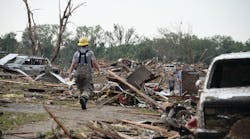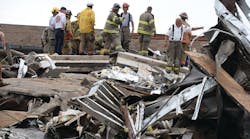Editor’s note: The major storms that swept through suburban areas around Oklahoma City in May 2013 provided distinct challenges to area response officials. The storm that struck Moore on May 20 in particular provides examples of how large-scale disasters can be managed effectively and offers valuable lessons for other communities.
One of the first priorities every fire officer learns in Incident Command System (ICS) training is to maintain the safety and security of your personnel. One element that led to an increase in the complexity of this disaster was the fact that the storm developed from a small cloud to a major tornado very quickly. Even with the rapidly developing system, the National Weather Service was still able to issue a tornado warning 16 minutes before the tornado hit the outer edges of the metropolitan area.
Oklahoma has a very high-tech system of weather forecasting and storm chasing where reporters can give minute-by-minute and block-by-block coverage of the path of a tornado. When this happens, officials have a good idea of where the storm is going to hit. Unfortunately, the Moore tornado’s rapid buildup and erratic behavior gave little opportunity to pinpoint its exact path. By the time the tornado reached the western edges of Oklahoma City and Moore, it was apparent that its track would take it directly through downtown Moore and eventually to the main police and fire stations. There was little more responders could do except survive by any means possible.
In this particular incident, Moore Fire Chief Gary Bird made the decision to abandon the fire station in the direct path of the tornado to an area about three miles south of town. Bird was quoted, “If we were going to lose the city’s new $8 million fire station, there was no need to lose the $2 million worth of equipment as well.” The decision to evacuate the personnel and equipment was made as early as possible and proved to correct. By comparison, response agencies elsewhere in the state that chose to “ride out” a similar-size storm returned to their stations to find both the equipment and the facility damaged beyond the ability to function, leaving potentially lifesaving responses out of the question for the immediate area.
It is important to note that evacuating emergency personnel ahead of a large storm would not be the correct decision in every case. It is likely that in the event of an F4 or F5 tornado, most of the civilian population would be evacuating at the same time, so emergency personnel and apparatus could be easily trapped by traffic in the full path of the storm. Even if the exact track of the tornado is known, the associated hail, flash flooding and high winds in the area of a tornado often are enough to damage equipment beyond its ability to respond. If any evacuation is ordered, it should be done as early as possible (preferably an hour or more, before the storm and only for the most deadly situation to avoid exposing personnel and equipment to extremely dangerous forces.
Establishing a strong “unified command”
As evacuated response units from Moore returned to the city, they quickly came face to face with total destruction. Thousands of splintered boards were sticking in the ground, as if someone had systematically drove them in the ground at exactly the same angle.
Dozens of people were helping their neighbors crawl out of numerous piles of debris. Hundreds of crumpled vehicles were heaped in a pile like someone had swept them into a corner. Injured civilians were wandering aimlessly through neighborhoods. Splintered utility poles were tangled in nests of live wires that littered every major intersection. Large sections of residential and commercial buildings were scattered across streets and highways, blocking traffic in every direction. Residential lots, with no visible evidence left of address, were found with driveways leading into indiscernible piles of rubble or empty slabs. Several homes burned freely in an area where no apparatus could gain access. Any one of these individual emergencies would normally require at least a single alarm by itself, but in this case, the full extent of the emergency was just beginning to unfold.
After the storm passed through downtown Moore, Bird saw that the main fire station had survived. Thanks to some quick thinking, that facility was immediately declared the primary location for the command post. Selecting a fixed location, rather than a mobile command post, provided incident commanders with plenty of room in the apparatus bay for the inevitable expansion of command staff. At the peak of the incident, well over 100 personnel from various state, local and federal agencies were actively involved in command and general staff functions within the command post. The fire station was well equipped with a backup generator, computers, radios, office supplies – and a bathroom.
The unification of command in one facility, where face-to-face resource planning and collaboration could take place, proved to be a tremendous advantage as the incident progressed. In contrast, the Oklahoma Office of Emergency Management (OEM) had identified more than 20 separate mobile command units from different response and volunteer organizations operating independently from command. This proved to be counterproductive until the agencies finally assimilated into the unified command structure toward the end of the day.
An early, unified and prioritized set of incident objectives, designed to meet the immediate needs of the incident, should be clearly communicated to all responders. After widespread storms, usually incident commanders will take control of the local 911 center quickly due to the inevitable wave of automatic alarm calls, leaking gas complaints and calls from civilians who are afraid. Calls received by dispatch should be “triaged” and then routed directly to the command staff for prioritization, not directly to field units that are usually engaged with search activities.
One tool Bird used to help the command staff identify and prioritize these objectives was the Oklahoma Incident Management Team (IMT). Upon the request of the City of Moore, the IMT help establish the incident command structure and incident objectives. This let the agency administrators, Bird and Police Chief Jerry Stillings, concentrate on policy-level decisions and activities. During the establishment of the IMT, the fire chief and police chief each appointed an incident commander to represent them in unified command, giving operators and tacticians the freedom to engage in the strategies and tactics of the operation without being whisked away by city officials or interrupted by media requests. Having an IMT to support unified command let Moore’s commanders identify the scope of the incident, prioritize requests and set the incident objectives that dictated the assignment of tasks throughout the incident.
The IMT provided a robust command and general staff for the unified commanders that included staffing all officers and section chiefs. The IMT’s team leader held the position of “deputy incident commander” and liaised between Moore’s unified command and the IMT. This let Moore’s commanders further identify and develop incident objectives and then leave them in the hands of the IMT to carry them out while their time and attention was demanded of them by the growing media and political machine.
Communications and emergency management
On the morning of May 20, Moore’s emergency manager, Gayland Kitch, was doing what every other emergency manager across Oklahoma was doing – watching weather bulletins as forecasts were updated. At 10 A.M., emergency managers around the state were gathered with their respective city managers and fire chiefs for a National Weather Service briefing on the impending storm outbreaks. Even before this meeting, Kitch had been busy updating the city’s website, issuing alerts and briefing his volunteer storm spotters – in short, doing everything he could to get the word out to the community to prepare for a bumpy ride.
Moore is fortunate to have an active group of volunteer emergency management staff. While city officials were being briefed on the weather, these individuals were already packing their trucks for a long day of storm spotting. As forecasted, the storms began to develop quickly; so fast that Moore’s volunteer storm spotters barely had time to get in place before the tornado dropped out of the clouds. Historically, tornadoes form around 5 to 6 P.M., but in this case, the tornado developed closer to 2 P.M.
When you assess resource management under the National Incident Management System (NIMS), it often paints a picture of the “trusty old emergency manager” (with his collection of walkie-talkies, cell phones and ham radios) standing next to the fire chief, ready to order any resource the chief requests. This can be an unrealistic expectation in Oklahoma, where local emergency managers are busy tracking the storm, gathering intelligence and activating the community’s storm-warning mechanisms. This is where the local emergency manager relies heavily on the staff. Of the many thousands of volunteers that would descend on Moore over the next few days and weeks, these first few volunteer emergency managers probably did as much to save lives and support the command post as anybody. One lesson learned from a local emergency management perspective is that a reliable core group of volunteer and/or assistant emergency managers is vital to the success of an operation this size, especially in the early stages of a developing incident.
Chief officers were requesting not only their local mutual aid partners, but state and national resources without the logistical support and tracking often provided by the local emergency manager. Due to the storm damage, many of these resources were having difficulty communicating with established staging areas or were creating alternate staging areas of their own until they were given an assignment. In the absence of interoperable communications in the early stage of the disaster, these assistant emergency managers were busy running information back and forth from the command post to the growing number of resources, delivering portable radios and oral assignments and bringing back status reports to command. (In after-action meetings, Bird noted that an aerial perspective of the scene would have been valuable in the early stages of the incident, but in its absence – due to the severe storms in the area – the assistant emergency managers were tasked with evaluating the affected areas of Moore and sending intelligence back to command about the overall scope of the incident.)
While Moore’s volunteer emergency managers were supporting the emergency, the local emergency managers was busy managing the phones. The seemingly endless number of calls from BBC, Tokyo, local, regional and national news led him to wonder where all these calls were coming from. A quick glance up at the TV answered the question – his main telephone number was being scrolled along the bottom of a national news station. Lesson learned: Consider keeping a telephone or other form of communication dedicated for use only during a disaster that is not on the city’s website and not available to the media. Having a secondary form of telephone communication would let the local emergency manager pass off his regular telephone (which is no longer of any use) to an assistant to screen calls, and use a dedicated line for coordination and request of resources between unified command, local emergency management and the state emergency management office.
The staging officer’s worst nightmare
One thing Oklahomans count on is volunteerism, usually in an overwhelming form of doctors, nurses, medical technicians, firefighters, neighbors, heavy equipment operators, police officers, students, soldiers and anyone else you can think of. Nothing generates more conversation about statewide emergency responder credentialing systems than those difficult situations staging managers find themselves in on almost every Type I incident.
After the storm hit Moore, a staging area was quickly established in the parking lot of the Warren Theatre, which had taken a direct hit from the tornado. It quickly became evident that the number of responders pouring into Moore led the staging manager to re-locate to a Home Depot Parking area one mile south of the original location. When the main staging area was identified by the media, it was broadcast over every TV and radio station across Oklahoma and Texas. As a result, the staging manager quickly became overwhelmed with countless self-dispatched resources. The task of tracking companies in staging became even more complicated when units began assigning themselves to a second- and even a third-level staging area because large amounts of debris was blocking their access to the identified staging area.
Oklahoma intermediate urban search and rescue (USAR) teams from Edmond, Lawton and Weatherford were specifically requested by command to help search hard-hit areas around Moore Medical Center and the Briarwood Elementary and Plaza Towers Elementary. These state teams were also finding it difficult to check in at staging and some eventually were tasked to respond directly into the scene. Many response units were unable to communicate with Moore’s command staff, so they found themselves waiting for assignments in the form of face-to-face requests.
Next: Identifying the challenges
PAT KING, NREMT, has been a member of the Oklahoma City. OK, Fire Department (OCFD) since 1992 and is currently a major at Station 18. He has served in various capacities within the fire service, including EMS training officer, OCFD Dive Team member and fire academy instructor. King has taught EMS and fire-related courses since 1995, including instructor and paramedic courses at Career Technology Centers in Central Oklahoma and is a licensed EMS educator. In addition to his full-time duties with OCFD, he joined the Oklahoma Office of Homeland Security (OKOHS) staff in 2008 as National Incident Management System (NIMS) compliance officer. Troy German of the Oklahoma Highway Patrol (OHP) and Johnny Vaughn of OKOHS also contributed to this article. Part one was in the December 2013 issue.
Pat King
PAT KING, NREMT, has been a member of the Oklahoma City. OK, Fire Department (OCFD) since 1992 and is currently a major at Station 18. He has served in various capacities within the fire service, including EMS training officer, OCFD Dive Team member and fire academy instructor. King has taught EMS and fire-related courses since 1995, including instructor and paramedic courses at Career Technology Centers in Central Oklahoma and is a licensed EMS educator. In addition to his full-time duties with OCFD, he joined the Oklahoma Office of Homeland Security (OKOHS) staff in 2008 as National Incident Management System (NIMS) compliance officer. Troy German of the Oklahoma Highway Patrol (OHP) and Johnny Vaughn of OKOHS also contributed to this article. Part one was in the December 2013 issue and part two was in the January issue.








